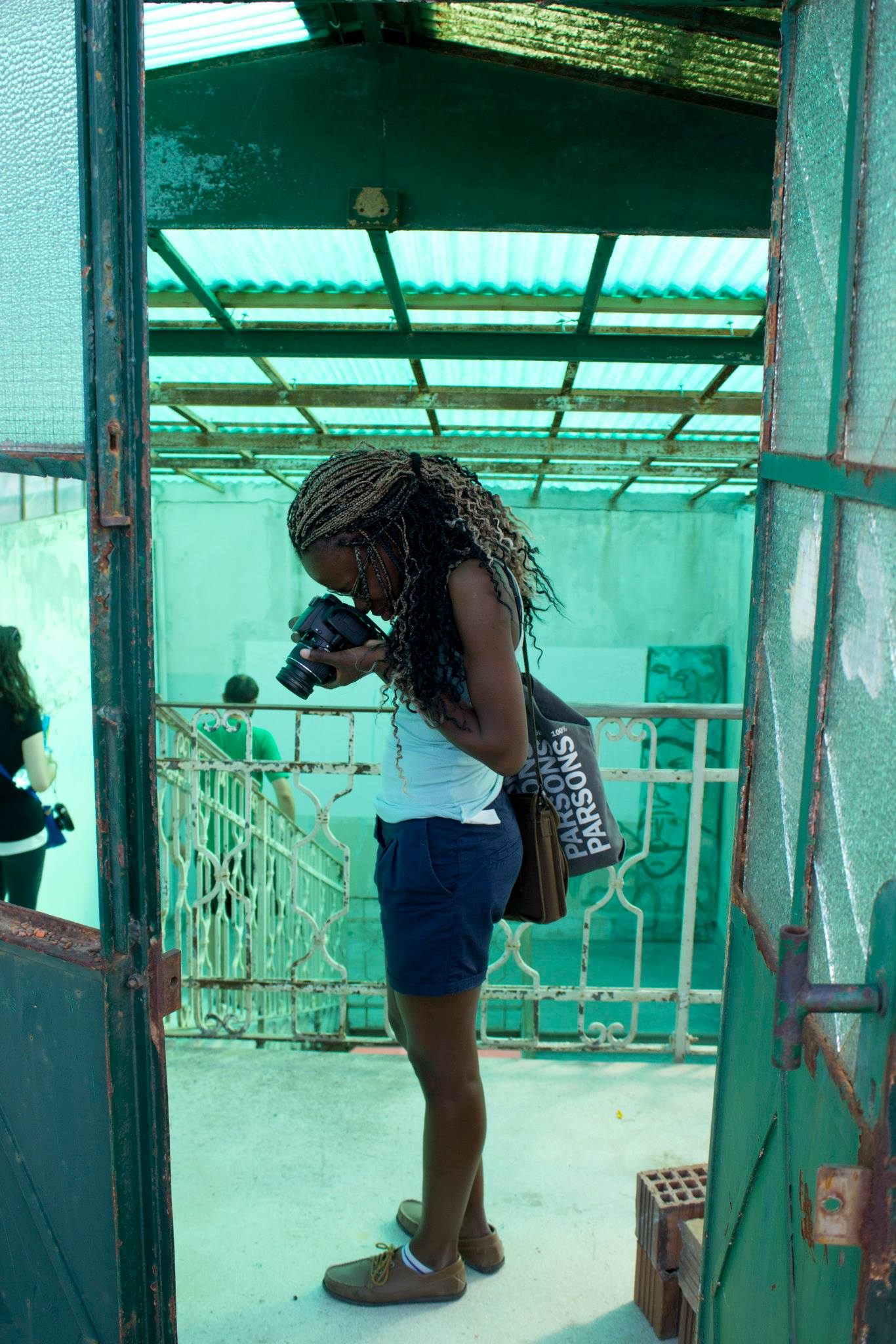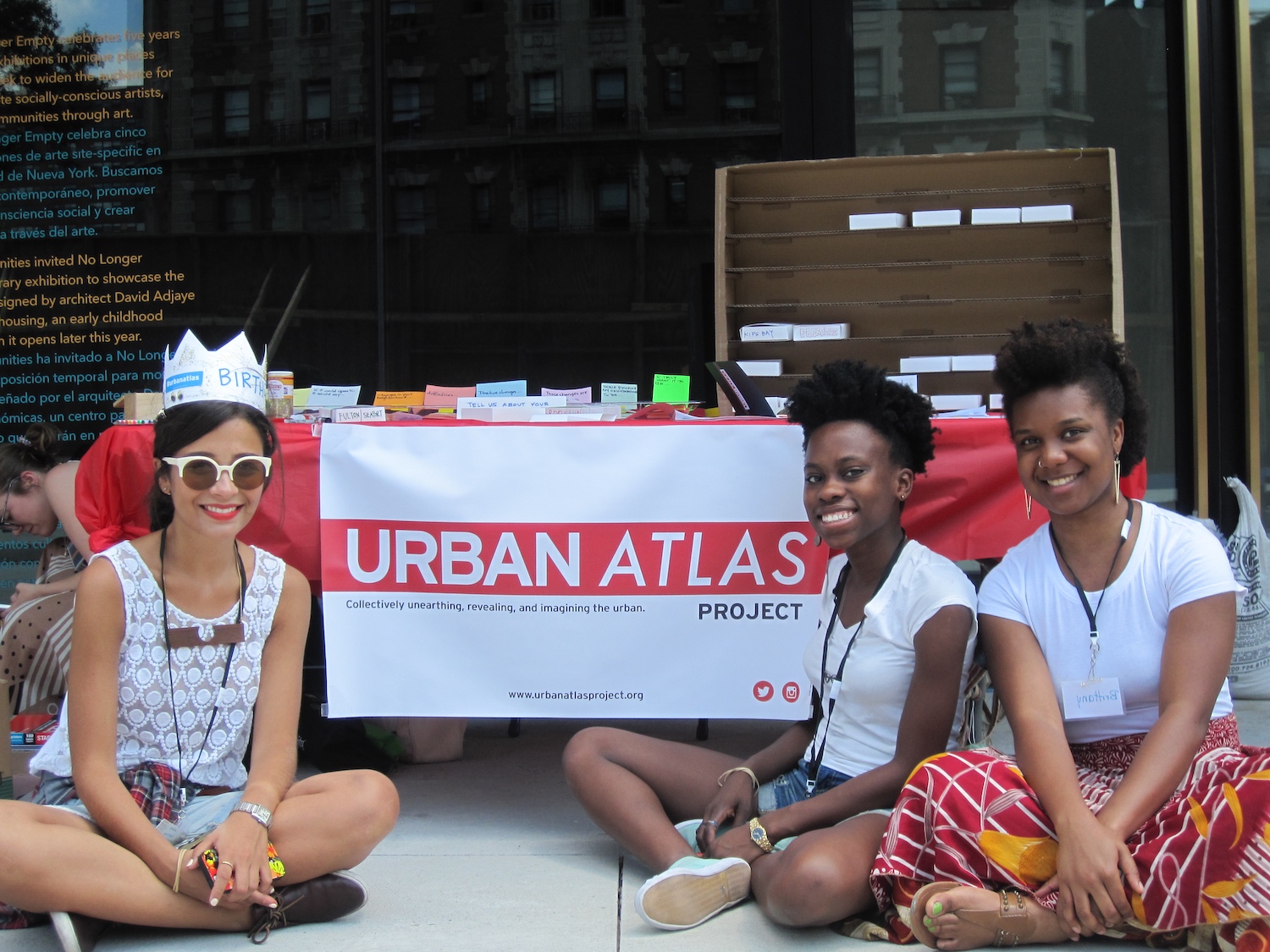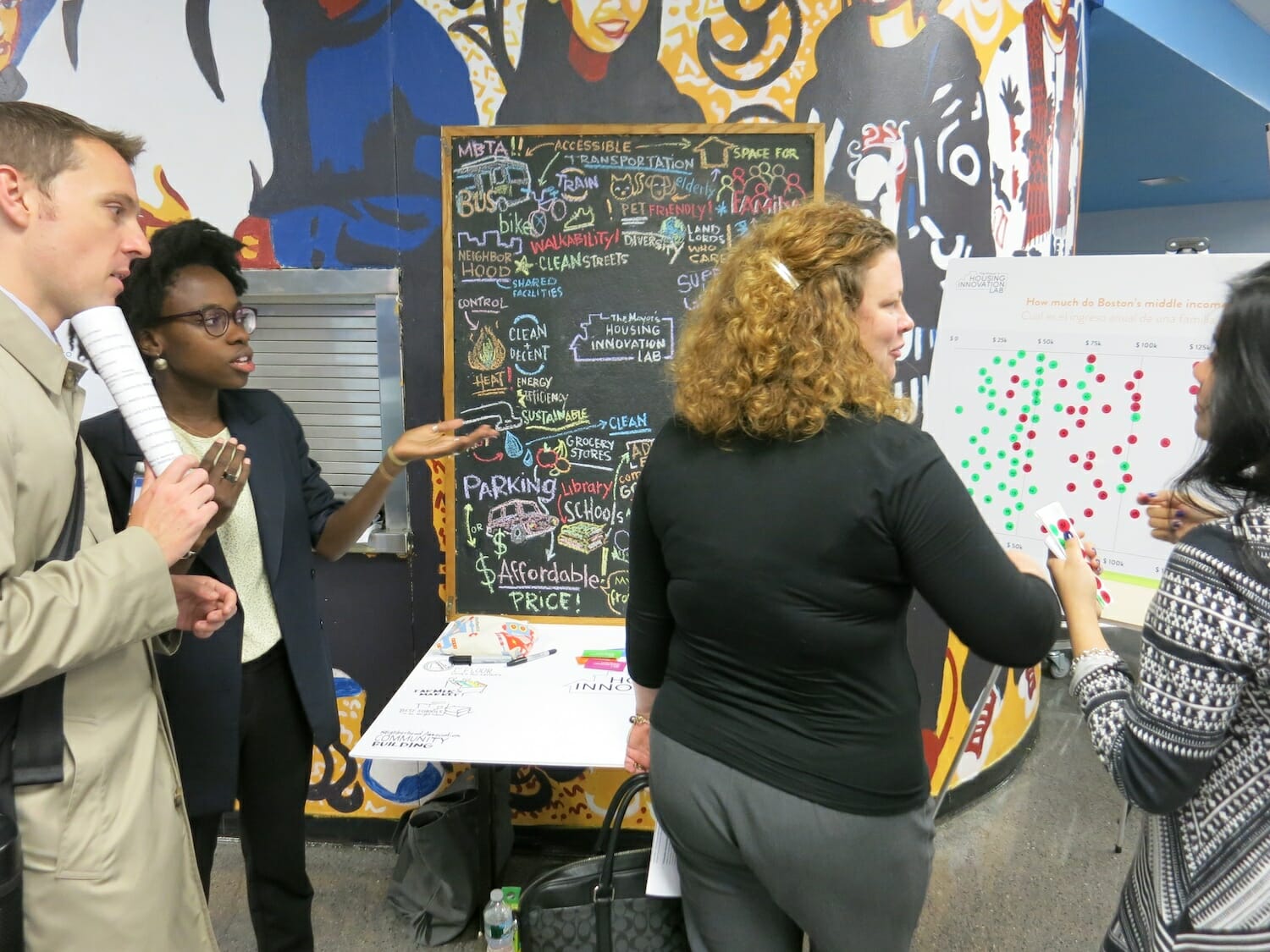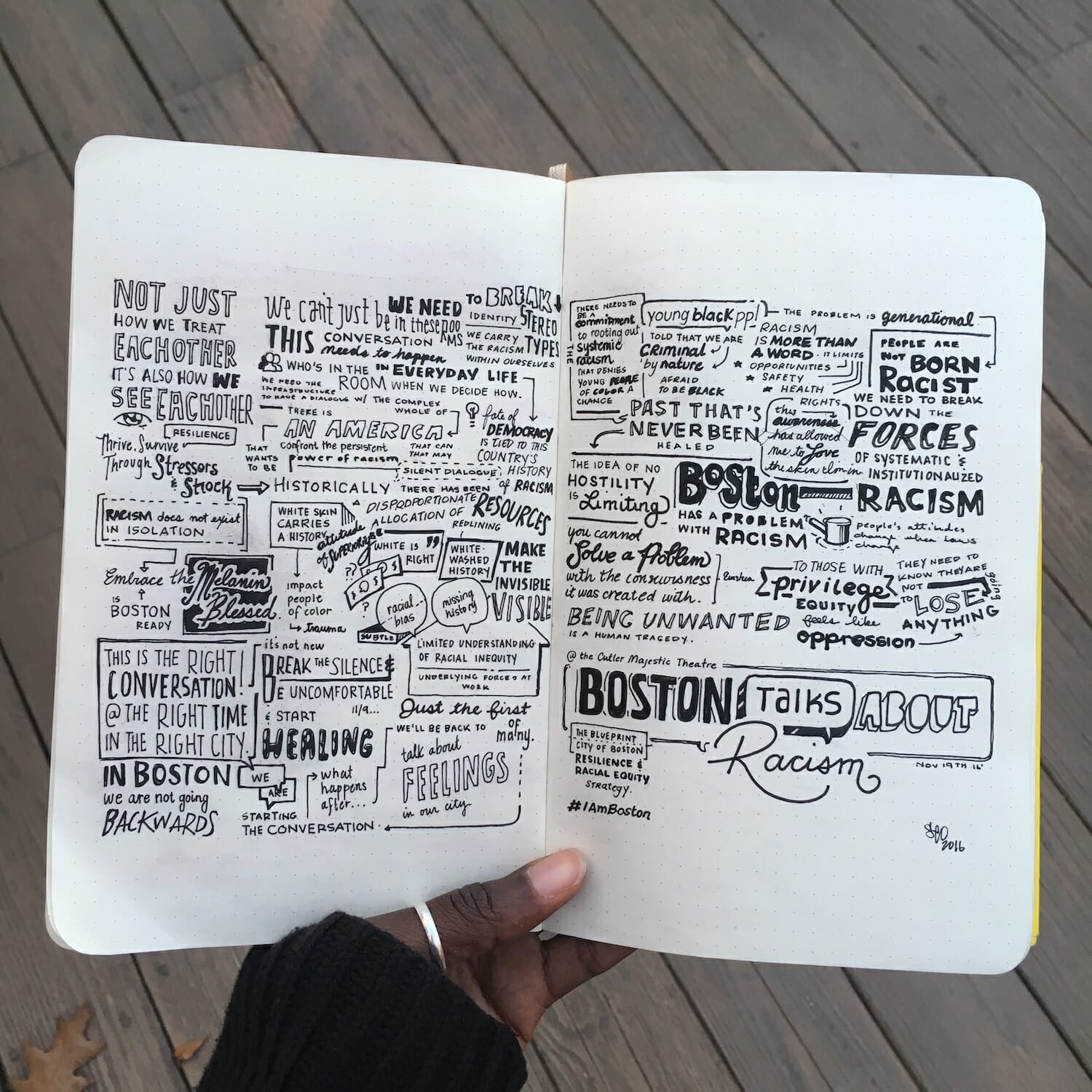
Sabrina Dorsainvil
Director of Civic Design • New Urban Mechanics
Sabrina Dorsainvil is a multidisciplinary designer and illustrator whose work ranges from playful drawings to strategic urban projects for the city of Boston.
Photo by Nancy Carbonaro, photos courtesy of Sabrina Dorsainvil
I am the only one in the institution that calls themselves a civic designer. During my time in the position I’ve been defining the practice while doing the work. I am managing projects but also working across our team in a visual design and strategic planning capacity. I’m thinking about our interactions with the public, how we frame the work that we do, where we can be creative, and how we might imagine a better city for all. I try to support folks in every way I can and help us build upon what we hope is reflective, value-driven practice—a practice centered on people.
Sabrina Dorsainvil is a multidisciplinary designer and illustrator whose work ranges from playful drawings to strategic urban projects. As the director of civic design for the City of Boston Mayor’s Office of New Urban Mechanics, her work centers on the human experience and uses creative approaches to address systemic issues within areas such as housing, public health and human rights. Fascinated by people and the way we interact with each other and everyday spaces, her artwork focuses on storytelling and finding simple ways of celebrating people and their humanity.
So much of what I do is founded in some of the struggles growing up in the context of being a child of immigrant parents with the idea of the American dream.
“I drew a lot as a kid. I remember sitting in front of the TV and not paying attention to it because I’d be doodling. It was my go-to hobby and when I thought about working in the context of art, all I knew at the time was animation and Disney, so I thought I’d be an illustrator,” she continued.
Sabrina previously worked with Designing the We, a social impact design studio, to bring to life the “Undesign the Redline” exhibition that exposes policies, practices, and investments that have perpetuated inequality in US cities. She has worked with international and local community-based organizations, non-profits, large institutions, and startups on issues regarding social, spatial, and environmental justice. She has also served as a visiting artist, educator, and lecturer in a variety of spaces.
She holds a BFA in industrial design from Massachusetts College of Art and Design (MassArt) and an MS in design and urban ecologies from Parsons School of Design. Along with being a national board director for The Creative Reaction Lab, Sabrina plays an active role in her local creative community as a 2017-2018 Neighborhood Salon Luminary and a 2019 Polly Thayer Starr Visiting Artist at the Isabella Stewart Gardner Museum in Boston, a member of the MassArt Alumni Leadership Council, and a public artist.

PErsonal History

Laying the Groundwork
Sabrina was born in Boston to Haitian parents. She spent her formative years in Lawrence, MA, where she attended the Greater Lawrence Technical School. She had several impactful jobs growing up. After school she worked in the graphic design and video production department at Movement City, a youth development program, and on the weekends she worked for an environmental justice organization called Groundwork Lawrence. She was part of a cohort of young people who learned about and led local environmental and healthy community initiatives. They did research, advocacy, service, and hands-on improvement projects throughout the Lawrence community.
“I caught wind of MassArt from an instructor at Movement City who was taking classes there and had some great things to say about the school, but was also critical about it, which I appreciated,” Sabrina said. “I attended one of her fashion shows and was able to see her version of design in action. It was really helpful to have someone to talk to who went there and was supportive of me trying to figure out what to do next.”
Sabrina earned a BFA in industrial design from Massachusetts College of Art and Design in 2012.
“My mind was open to all the other things I could do at technical school, from biotechnology to carpentry,” Sabrina said. “I chose to study graphic communications, because it paired the production side of the graphic design world with a fine art track. Alongside traditional academics, every other week I would be in class doing pastel drawings, painting, and sculpting. I’d also be in classes where I’d learn how to develop film, work on a press, and practice desktop publishing. I was learning hands on about ways art and design were applied in the real world.”
Centering on Cities
After graduating from MassArt, Sabrina joined Parsons’ The New School’s first cohort of the Master of Science in design and urban ecologies graduate program. This program spoke to her. They were looking for people who come from diverse backgrounds to come together to address complex issues in the context of a city.
There is a whole side to the New School I didn’t know at first,” Sabrina said. “There were years and years of activists and asylum seekers, all of these minds—artists, philosophers, and folks who are trying to push up against and make sense of the way we accept life as is today. I had constant reminders that equity, diversity, and justice had to always be in mind—this wasn’t a world designed for us and it won’t serve us as is.”
Her thesis was the creation of the Urban Atlas Project, a resource platform and archive of narratives around urban development. It was for residents, youth, and artists to come together, share their stories and find tools to better navigate change in their cities.

From Strategies to Exhibitions
After graduating from Parsons and moving back to Boston, Sabrina worked at Continuum, a design and innovation consultancy. In her role as an envisioner and design strategist, she focused on health and financial services. Soon after, she began commuting and working with old classmates at the NYC-based social impact design studio, Designing the We. She was a co-designer of the initial “Undesign the Redline” exhibition. It shares the history of redlining across the United States and the impact of structural racism on our cities. (Redlining was a 1930s housing policy that led to the denial of resources to communities of color and used geography as a way to continue to divide our cities by race and class).
Recently, Sabrina has collaborated with the Boston Public Health Commission and the Office of Recovery Services in creating the Engagement Center in Boston’s Newmarket area. The space supports people navigating substance use disorders and housing insecurity, and provides basic needs like restrooms, coffee, and phone charging stations as well as recovery and health services. Her team focused on making the space more welcoming and connective through physical design changes and creative programming.
In 2015, Sabrina accepted a position at the City of Boston Mayor’s Office of New Urban Mechanics, a civic design and innovation team in city government, as a civic designer. They weren’t looking for an expert in housing or policy, rather someone with experience and novel approaches to engaging with people and designing in cities. She has since become the director of civic design, working on projects aimed at improving the strength and well-being of her local community.

I’ve had the opportunity to create infographics for parking pilots, design public health initiatives, strategize around affordable housing, and even start thinking about autonomous vehicles. We work on everything from streetscapes and future mobility to thinking about safe spaces for people who are at the margins. We aren’t always the experts, but we’re invited into spaces to ask a different set of questions and experiment.





